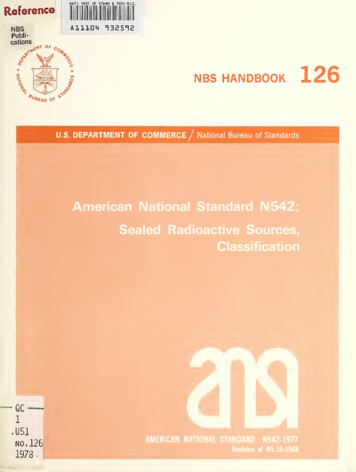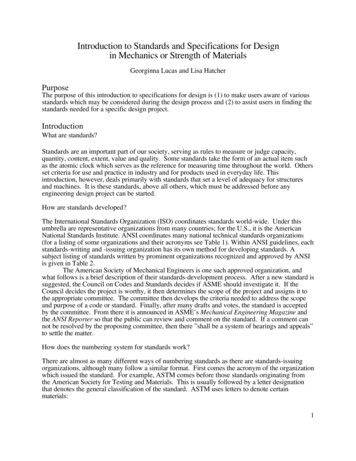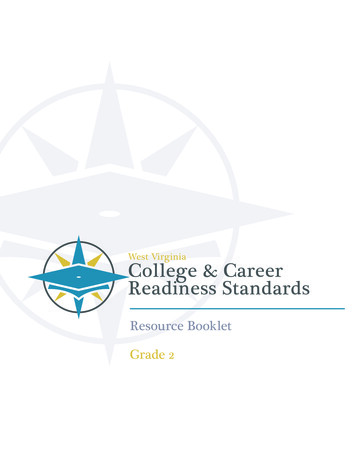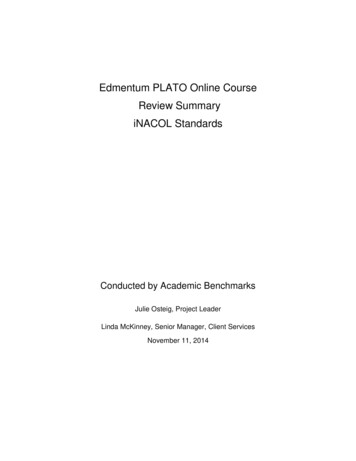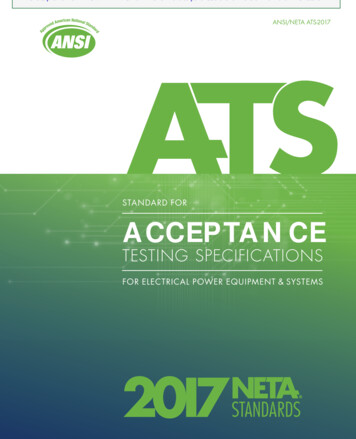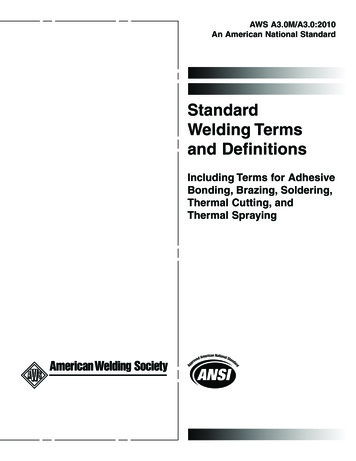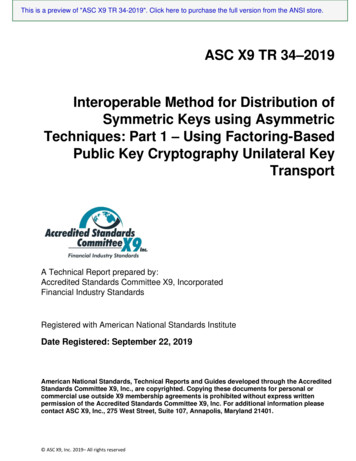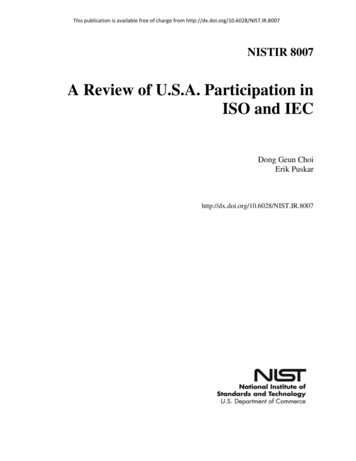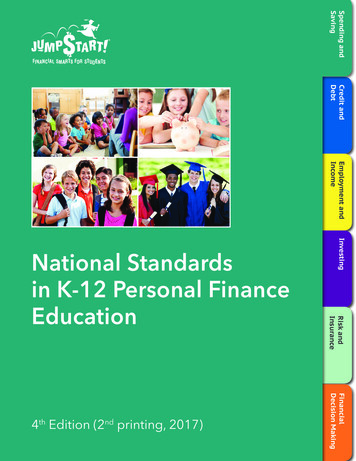
Transcription
Spending andSavingCredit andDebtEmployment andIncomeInvestingFinancialDecision Making4th Edition (2nd printing, 2017)Risk andInsuranceNational Standardsin K-12 Personal FinanceEducation
Jump tart Coalition for Personal Financial Literacy1001 Connecticut Avenue NWSuite 640Washington, DC 20036Phone: house.org
Contents1Introduction2Using the National Standards4Acknowledgments6The Standards8Spending and Saving14Credit and Debt20Employment and Income24Investing30Risk Management and Insurance34Financial Decision Making44Sustaining Partners45Jump tart Coalition Partners and Affiliates
1IntroductionThe 2015 edition of the National Standardsin K-12 Personal Finance Education ispublished by the Jump tart Coalition forPersonal Financial Literacy on behalf of itspartners—from business, finance, government,academia, education, associations andother sectors—and its 51 independent stateaffiliates.the definition of any word or term variesslightly from one dictionary to the next. TheJump tart Coalition defines financial literacyas “the ability to use knowledge and skills tomanage one’s financial resources effectivelyfor a lifetime of financial security” andacknowledges that other good definitionsexist.These National Standards delineate thepersonal finance knowledge and ability thatyoung people should acquire throughouttheir kindergarten through 12th grade schoolyears (K-12) to emerge as independent adultconsumers, fully prepared to make wisefinancial decisions for a lifetime of financialwell-being. The National Standards representthe framework of a comprehensive personalfinance curriculum that begins early inelementary school, builds on foundationalknowledge and results in high schoolgraduates who are competent, confidentmanagers of their own money.In defining financial literacy, two key elementsare common among several sources: therecognition that financial literacy is more thanjust knowledge or information; and, that theability to use information and resources is keyto achieving and maintaining financial wellbeing.Advancing Financial LiteracyThe goal of financial education is to helpstudents achieve a level of financial literacy;to help them become financially capableconsumers.There is no single definition of “financialliteracy,” “financial capability,” “financialwell-being” or similar terms, much asThe Jump tart Coalition believes thatfinancial literacy is not an absolute state;but rather, a continuum of abilities that issubject to variables throughout the life cycle.It is an evolving state of competency thatenables individuals to respond effectivelyto ever-changing personal and economiccircumstances. Further, it matters less thata high school graduate can define financialterms and more that he or she can findanswers and evaluate factors toward makingsound financial decisions.
2Using the National StandardsThe National Standards in K-12 PersonalFinance Education were designed to guideclassroom education, extra-curricular learningand the development of financial educationprograms, materials and tools.Throughout the country, educationalrequirements are established by states,territories and local jurisdictions—suchas cities, counties and school districts—to best meet local needs. Financialeducation requirements, like all educationrequirements, vary to some extent fromone location to the next. With this in mind,the Jump tart Coalition does not expectthe National Standards to be adopteduniformly throughout the country; but rather,believes they should serve as a model thatpromotes consistency, while supporting localcustomization.Just as these National Standards support thedevelopment of new programs and materials,they also serve as a guide to help teachersand administrators utilize the many curriculumresources available to them—especially whenthey combine, blend and adapt resourcesand activities for a most robust and relevantlearning experience. Jump tart encourageseducators to use resources that align withthe National Standards. Many of theseresources—from a wide variety of providers—can be found on the Jump tart Clearinghouseat www.jumpstartclearinghouse.org.Jump tart recognizes personal finance as amulti-disciplinary subject and the NationalStandards draw from a number of academicareas including mathematics, economics,business and consumer science. Likewise,the 2015 National Standards in K-12 PersonalFinance Education are intended to supporteducational endeavors in these other subjectareas, as well.Finally, while these National Standardsare designed specifically to support K-12classroom education, they can be easily andeffectively used to guide informal educationoutside the classroom and at home; postsecondary and adult education; professionaldevelopment for teachers, counselors andothers; and other initiatives. The Jump tartCoalition uses these National Standards as thebasis for evaluating resources to be listed inthe Jump tart Clearinghouse.OrganizationStandardsIn the 2015 edition of the National Standards,the standards for the six major categoriesof personal finance instruction have beenrelabeled: Spending and Saving, Credit andDebt, Employment and Income, Investing,
3Risk Management and Insurance andFinancial Decision Making. Each categorybreaks down an overall competency derivedfrom Jump tart’s definition of financialliteracy into its principal components. Theresulting standards and benchmarks describethe instructional building blocks for acomprehensive K-12 curriculum.Knowledge StatementsWhile not meant to be exhaustive, theknowledge standards show the key personalfinance concepts underlying the standardsand benchmarks. They provide guidancefor publishers as they develop and reviseresources and for educators as they selectclassroom materials and plan their lessons.BenchmarksThe benchmarks describe the skills thatdemonstrate students’ ability to applyknowledge to everyday financial decisions andactions at four points in their developmentas consumers. Reading from left to right oneach page, each standard’s benchmarks showa progression in which earlier knowledge laysthe groundwork for increasing complexity ofknowledge and achievement as students age.Evolution of the National StandardsIn 1998, the Jump tart Coalition publishedPersonal Finance Guidelines and Benchmarks,the first known national standards in financialeducation. A group of 20 professionalsrepresenting a broad range of education,government and financial servicesorganizations worked together to developthese original guidelines. An updated versionwas published in 2001.In 2006, as the world-wide financial educationeffort evolved and matured, a new Jump tarttask force undertook a major revision ofthe National Standards—expanding theoriginal four content categories into six andincorporating new ideas about effectivefinancial education. Seven experts in financialeducation were appointed to the task forceand nearly 50 reviewers from business, finance,government and education—includingclassroom teachers—participated in thecreation of the new set of standards. Availableearly in 2007, the new National Standardsin K-12 Personal Finance Education gainedwidespread utilization with free distributionthrough the Federal Citizen Information Centerand online access at www.jumpstart.org.
4Now in its fourth edition, the 2015 NationalStandards in K-12 Personal Finance Education,were unveiled Nov. 8, 2014, at the Jump tartNational Educator Conference in Los Angeles,to an audience consisting primarily ofclassroom teachers. The current standardsare an update of the 2007 publication, withnew kindergarten benchmarks as the mostsignificant addition.Recognizing that children develop an interestin money and begin to learn financial basicswell before entering school, Jump tart addedkindergarten knowledge statements andbenchmarks to guide both informal instructionand the preschool/kindergarten classroomintroduction to concepts and skills that canprovide a foundation for personal financeeducation in later grades.Thrive by Five: Teaching Your PreschoolerAbout Spending and Saving* was used asa resource in the development of the newkindergarten benchmarks.Editorial TeamRosella Bannister, Jump tart Clearinghouseconsultant and retired director of the NationalInstitute for Consumer Education at EasternMichigan University; Philip Heckman, retireddirector of youth programs for the CreditUnion National Association, who developedCUNA’s preschool financial curriculum, Thriveby Five; and Susan Sharkey, director of theHigh School Financial Planning Program at theNational Endowment for Financial Educationand former instructional designer with theWorldwide Instructional Design System andhigh school business educator, updated the2007 version of the National Standards andwrote new content to create this book. Theirwork was further guided by the nationalJump tart Coalition staff and more than 40reviewers representing Jump tart nationalpartners, state affiliates, classroom educatorsand other stakeholders.* Thrive by Five : Teaching Your Preschooler About Spending and Saving is an activity program for parents developed bythe Credit Union National Association with the help of Cooperative Extension and funding from the National Credit UnionFoundation.
5AcknowledgmentsThe Jump tart Coalition and National Standards working team express our profound appreciationand gratitude to the dedicated and knowledgeable professionals, who volunteered their timeto review these standards and provide invaluable feedback.* The 2015 edition of the NationalStandards in K-12 Personal Finance Education would not be possible without their expertise andcommitment to advancing financial literacy among our nation’s youth.Jump tart Coalition National PartnersRhonda Ashburn, National Foundation forCredit CounselingVickie Bajtelsmit, Ph.D., JD, Colorado StateUniversityL. Boyer, Federal Reserve Board of GovernorsJoanne Cuthbertson, CFP, CharlesSchwab & Co., Inc.Theodore R. Daniels, Society for FinancialEducation and Professional Development, Inc.Phyllis Frankfort, Working in Support of Education(W!SE)Robert Ganem, FINRA Investor EducationFoundationChristiane Gigi Hyland, National Credit UnionFoundationTiffany Kirk, Regions BankJohn Lanza, the Money Mammals by SnigglezooDiane Mattis, InVEST and the IndependentInsurance Agents & Brokers of AmericaSara Messina, Federal Reserve Board ofGovernorsBrian Mulford, U.S. Securities and ExchangeCommissionJeni Pastier, American Bankers AssociationCarrie Schwab Pomerantz, Charles SchwabFoundationPatrick Rowan, The National Theatre for ChildrenL. Shane Thomas, DECA, Inc.Gerri Walsh, FINRA Investor EducationFoundationRebecca Wiggins, Association for FinancialCounseling and Planning EducationClassroom EducatorsKristen Addison, Ludlow-Taylor ElementarySchool, Washington, DCAmy Badt, Santa Monica Malibu School District,CaliforniaMaryBeth Bailey, Bryant Public Schools, ArkansasJoel Chrisler, Sauk Prairie School District,WisconsinKellie Haayer, Klein Independent School District,TexasSheila Miller, Newfound Regional High School,New HampshireBrian Page, Reading High School, OhioJoey Running, West Albany High School, OregonKey StakeholdersAnne Bannister, CFP, Personal Finance EducationServices and the Jump tart CoalitionJim Charkins, Ph.D., California State University,San BernardinoJulie Heath, Ph.D., University of CincinnatiAmy Hennessy, Federal Reserve Bank of AtlantaJeanne M. Hogarth, Ph.D., Center for FinancialServices InnovationElizabeth Kiss, Ph.D., Kansas State UniversityValerie Klein, Ph.D., The Math Forum @ DrexelUniversityJackie Morgan, Federal Reserve Bank of Atlanta,Nashville BranchBarbara O’Neill, Ph.D., Rutgers UniversityDan Rutherford, Consumer Financial ProtectionBureauRoyce Webster, Jr., Tinker Federal Credit Union* Some reviewers elected to participate anonymously.
6The StandardsSpending and SavingOverall CompetencyApply strategies to monitor income and expenses, plan for spending and save for future goals.Standard 1. Develop a plan for spending and saving.Standard 2. Develop a system for keeping and using financial records.Standard 3. Describe how to use different payment methods.Standard 4. Apply consumer skills to spending and saving decisions.Credit and DebtOverall CompetencyDevelop strategies to control and manage credit and debt.Standard 1. Analyze the costs and benefits of various types of credit.Standard 2. Summarize a borrower’s rights and responsibilities related to credit reports.Standard 3. Apply strategies to avoid or correct debt management problems.Standard 4. Summarize major consumer credit laws.Employment and IncomeOverall CompetencyUse a career plan to develop personal income potential.Standard 1. Explore job and career options.Standard 2. Compare sources of personal income and compensation.Standard 3. Analyze factors that affect net income.
7The StandardsInvestingOverall CompetencyImplement a diversified investment strategy that is compatible with personal financial goals.Standard 1. Explain how investing may build wealth and help meet financial goals.Standard 2. Evaluate investment alternatives.Standard 3. Demonstrate how to buy and sell investments.Standard 4. I nvestigate how agencies protect investors and regulate financial markets andproducts.Risk Management and InsuranceOverall CompetencyApply appropriate and cost-effective risk management strategies.Standard 1. Identify common types of risks and basic risk management methods.Standard 2. Justify reasons to use property and liability insurance.Standard 3. Justify reasons to use health, disability, long-term care and life insurance.Financial Decision MakingOverall CompetencyApply reliable information and systematic decision making to personal financial decisions.Standard 1. Recognize the responsibilities associated with personal financial decisions.Standard 2. Use reliable resources when making financial decisions.Standard 3. Summarize major consumer protection laws.Standard 4. M ake criterion-based financial decisions by systematically considering alternativesand consequences.Standard 5. Apply communication strategies when discussing financial issues.Standard 6. Analyze the requirements of contractual obligations.Standard 7. Control personal information.Standard 8. Use a personal financial plan.
Spending andSaving8Spending and SavingOverall CompetencyApply strategies to monitor income and expenses, plan for spending and save forfuture goals.Knowledge StatementsKindergarten4th Grade8th Grade12th Gradea. P lanning helps peoplemake choices about howto use their money.a. Many factors andexperiences, such as rolemodels and peer pressure,affect spending patterns.a. A spending plan is a guidefor deciding how to useincome to meet currentobligations and futuregoals.a. W ealth consists ofaccumulated assets thatrepresent positive networth.Knowledge Statementsb. Spending, saving andsharing are ways to usemoney.c. A trade is possible whenboth parties are satisfiedwith the benefits received.d. People trade money tobuy goods or services(tasks performed byothers).e. Different goods or serviceshave different prices.f. Some goods or services areavailable without fees.g. People pay for goods orservices in different ways.h. Paper money and coinshave different values.i. Saving means choosing notto spend money today inorder to buy something inthe future.j. There are two kindsof sharing: Somethingshared that does not haveto be returned is a gift.Something borrowed mustbe returned.k. One way people helpothers is by giving money.l. People in a communityshare the cost of servicesavailable to everyone, suchas police protection.Additional KnowledgeStatementsb. A spending plan (budget)is a guide to help peoplebalance money coming in(income) and money goingout (expenses).c. Writing a check, usinga debit or credit card orpaying online or with amobile device or with cashare all ways of spending.d. Saving means choosingto set aside money foremergencies and futureneeds and goals.e. People are required topay taxes, for which theyreceive governmentservices.Additional KnowledgeStatementsb. S pending behaviors andhabits affect personalsatisfaction.c. P eople perform routine,often daily, tasks tomanage money.d. S ome payment methodsare more expensive thanothers.e. E very spending andsaving decision has anopportunity cost.f. Inflation reduces consumerpurchasing power overtime.g. E mergency savings canhelp avoid going intodebt.h. T axes affect disposableincome and the total costof many purchases.Additional KnowledgeStatementsb. C ertain expenses, suchas home loan interestand charitable donations,might be tax deductible.
Standard 1. Develop a plan for spending and saving.Kindergarten4th Grade8th Grade12th Gradea. D ecide uses for personalfunds.a. Explain how saving moneycan improve financial wellbeing.a. A ssess how spendingpriorities reflect goals andvalues.a. U se a plan to managespending and achievefinancial goals.b. Create a way to keep trackof money spent.b. A nalyze how spending andsaving behavior can affectoverall well-being.b. S pecify how monetary andnon-monetary assets cancontribute to net worth.c. D iscuss the components ofa personal spending plan,including income, plannedsaving and expenses.c. A nalyze how changes inlife circumstances canaffect a personal spendingplan.Benchmarksb. S hare an experience ofwaiting to have enoughmoney to buy something.c. P redict possible spendingdecisions in advance of afamily trip or other specialoccasion.d. T ell about a personalsavings goal in terms ofa special occasion in thenear future, such as a giftor special event.e. Explain why money savedin a bank or credit union isstill a personal belonging.f. S how how to add money toand withdraw money from apersonal account in a bankor credit union.g. P oint out examples ofalternatives to activitiesthat charge fees.h. Differentiate betweenprivate and publicproperty.i. E xplain how receiving a toyas a gift is different fromsharing a friend’s toy whileplaying.Additional Benchmarksc. Categorize types ofhousehold expenses andsources of income.d. Calculate the sales tax fora given purchase.e. Describe ways that peoplecan decrease expensesto save more of theirincomes.f. Demonstrate how toallocate weekly incomefor spending, saving andsharing goals.g. Give an example of howgovernment uses taxrevenues.Additional BenchmarksAdditional Benchmarksd. Compare saving strategies, d. I nvestigate changesincluding “Pay Yourselfin personal spendingFirst” and comparisonbehavior that contribute toshopping.wealth building.e. C ompare the advantagesand disadvantages ofsaving for financial goals.f. Illustrate how inflation canaffect spending power overtime.g. J ustify the value of anemergency fund.h. E xplain why saving is aprerequisite to investing.e. D etermine how charitablegiving fits into a spendingplan.Spending andSaving9
Spending andSaving10Standard 2. Develop a system for keeping and using financial records.Kindergarten4th Grade8th Grade12th Gradea. C reate a way to keep trackof money saved for futurespending.a. Monitor financialstatements for a personalsavings account.a. P repare a personalproperty inventory,including descriptions,locations and estimates ofvalue.a. I nvestigate accountmanagement servicesthat financial institutionsprovide.BenchmarkAdditional Benchmarksb. Set up a system to keeptrack of household productinformation, such asproduct warranties andreceipts.Additional Benchmarksb. D evelop a system fororganizing personalfinancial records, bothpaper and electronic.c. I nvestigate ways to securevital personal financial dataand records.Additional Benchmarksb. D ifferentiate betweenan expense that is taxdeductible and one thatis not.c. D evise a system to retainevidence of tax-deductibleexpenditures.d. I nvestigate the recordsrequired to claim possibletax credits.
Standard 3. Describe how to use different payment methods.Kindergarten4th Grade8th Grade12th Gradea. S ort coins and papermoney by appearance andname.a. Justify reasons to keepmoney in a bank or creditunion.b. Count items up to 10.b. Demonstrate how checksand debit cards, gift cardsand credit cards work aspayment methods.a. C ompare and contrastdifferent types of localfinancial institutions andthe services they provide.a. S ummarize the risks andprotections of checks,stored value cards, debitcards, gift cards and onlineand mobile paymentsystems.BenchmarksAdditional Benchmarksc. Verify the total cost of apurchase that includesmultiple items.d. Calculate the amount ofchange to be returnedwhen the paymentamount is greater than thepurchase price.Additional Benchmarksb. S ummarize the advantagesand disadvantages ofchecks, stored value cards,debit cards, gift cardsand online and mobilepayment systems.c. V erify sales receiptsfor accuracy, includingcalculations, sales tax andany fees.Additional Benchmarksb. C ompare the featuresand costs of personalchecking accounts offeredby different financialinstitutions.c. C ompare the features andcosts of online and mobilebill payment servicesoffered by differentinstitutions.d. C ompare the costs ofcashing a check withvarious third parties, suchas a bank or credit union,check-cashing services andretail outlets.e. D emonstrate how toschedule and manage billpayments.f. Write a check.g. R econcile a checkingaccount.h. E xplain how to verifyprinted and online accountstatements for accuracy.Spending andSaving11
Spending andSaving12Standard 4. Apply consumer skills to spending and saving decisions.Kindergarten4th Grade8th Grade12th Gradea. E xplain why somespending transactionsreturn change to the buyerand some do not.a. Compare prices for thesame item from twodifferent sources.a. E valuate the relationshipbetween spendingpractices and achievingfinancial goals.a. D emonstrate how to usecomparison shopping skillsto buy and finance a car.Benchmarksb. Assemble a grocery orother shopping list for thefamily.c. Locate familiar items andcomparable alternativeswhile grocery shopping.d. Explain why comparablestore items might beoffered at different prices.e. Explain how charitablegiving differs from sharingtoys with a friend.f. Identify personalpossessions that aresuitable for donation to acharity.Additional Benchmarksb. Justify a spending decisionbased on pre-determinedcriteria for an acceptableoutcome and availableoptions.c. Explain how peer pressurecan affect spendingdecisions.Additional Benchmarksb. A nalyze how externalfactors, such as marketingand advertisingtechniques, mightinfluence spendingdecisions for differentindividuals.c. W hen making a consumerdecision, consider a rangeof spending and nonspending alternatives.d. I llustrate the effect ofinflation on buying power.e. I nvestigate a privatecharitable organization andits purpose.Additional Benchmarksb. C ompare the advantagesand disadvantages ofowning a house versusrenting.c. R esearch the average costsof all expenses associatedwith a four-year collegeeducation, a wedding anda new versus used car.d. E valuate specific charitiesbased on purpose,management, outcomes orresults and reputation.
13
14Credit and DebtOverall CompetencyDevelop strategies to control and manage credit and debt.Credit andDebtKnowledge StatementsKindergarten4th Grade8th Grade12th Gradea. S ometimes people canborrow money or an item ifthey promise to return it.a. Credit is a basic financialtool.a. C redit allows borrowers touse big-ticket items whilepaying for them.a. L easing, borrowing to buyand rent-to-own optionshave different contractterms and costs.Knowledge Statementsb. Borrowers have theresponsibility to returnitems in good condition.Additional KnowledgeStatementsb. Borrowing money to buysomething usually costsmore than paying cashbecause there is a price(interest and fees) forbuying on credit.c. Borrowers who repay aspromised show that theyare worthy of using creditin the future.Additional KnowledgeStatementsb. C onsumers can choose toborrow from a variety ofcredit sources.c. C omparing the costs andbenefits of buying oncredit is key to making agood borrowing decision.d. F or any given loan amountand interest rate, thelonger the loan period andthe smaller the monthlypayment, the larger thetotal cost of credit.e. S ometimes changingcircumstances affectpeople’s ability torepay what they haveborrowed, which can haveconsequences such asrepossession, garnishment,tarnished borrowingreputation and increasedcredit costs.Additional KnowledgeStatementsb. C redit cost disclosureinformation is useful inmanaging borrowingexpense.c. C onsumers with excessivedebt can work directly withlenders to regain control,with options that includeloan consolidation andrenegotiation of repaymentschedules, rather than bypaying a third-party “creditrepair” company.d. B ankruptcy provides debtrelief, but has seriousnegative consequences.e. C redit bureaus maintaincredit reports, whichrecord borrowers’ historiesof repaying loans.f. Negative information incredit reports can affect aperson’s credit score andfinancial options.g. F ederal and state laws andregulations offer specificprotections for borrowers.h. L enders sometimesrequest collateral to securea loan.i. Debt reduces net worth.j. C redit allows businesses toleverage assets for currentoperations and futureexpansion.
15Kindergarten4th Grade8th Grade12th Gradea. E xplain why somethingborrowed must bereturned.a. Identify situations whenpeople might pay forcertain items in smallamounts over time.a. A ssess whether a specificpurchase justifies the useof credit.a. C ompare the cost ofborrowing 1,000 bymeans of differentconsumer credit options.Benchmarksb. E xplain the differencebetween buying andborrowing.Additional Benchmarksb. Summarize the advantagesand disadvantages ofusing credit.c. Explain why financialinstitutions lend money.d. Explain why using acredit card is a form ofborrowing.Additional Benchmarksb. E xplain how debit cardsdiffer from credit cards.c. E xplain how interest rate,compounding frequencyand loan length affect thecost of using credit.d. C alculate the total costof repaying a loan undervarious rates of interestand over different periods.e. D iscuss potentialconsequences of using“easy access” credit.f. Explain how individuals usedebt as an investment.Additional Benchmarksb. E xplain how credit cardgrace periods, methodsof interest calculationand fees affect borrowingcosts.c. C ategorize the types ofinformation needed whenapplying for credit.d. C ompare the total costof reducing a credit cardbalance to zero withminimum versus aboveminimum payments, allother terms being equaland no further purchasesbeing made.e. D ecide the most costeffective option for payingfor a car.f. Differentiate among varioustypes of student loans andalternatives as a means ofpaying for post-secondaryeducation.g. P redict the potentialconsequences of deferredpayment of student loans.h. D ifferentiate betweenadjustable- and fixed-ratemortgages.i. E xplain the effect of debton a person’s net worth.j. E xplain how businessowners use debt asleverage.Credit andDebtStandard 1. Analyze the costs and benefits of various types of credit.
16Credit andDebtStandard 2. Summarize a borrower’s rights and responsibilities relatedto credit reports.Kindergarten4th Grade8th Grade12th Gradea. E xplain how to take care ofsomething borrowed.a. Describe the qualitiesthat would be desirablein a person who borrowsa favorite personalpossession.a. R ecommend ways thata person can regain alender’s trust after losingor damaging borrowedpersonal property.a. S ummarize onlineinformation about the FairCredit Reporting Act.BenchmarkAdditional BenchmarksAdditional Benchmarksb. Give examples ofb. W eigh the potentialreasonable conditions topayoffs of a positiveset for the use of borrowedborrowing reputationpersonal property.versus the potentialconsequences of a poorborrowing reputation.Additional Benchmarksb. E xplain the value of creditreports to borrowers andto lenders.c. G ive examples ofpermissible uses of a creditreport other than grantingcredit.d. I dentify the primaryorganizations that maintainand provide consumercredit records.e. C ategorize the informationin a credit report and howlong it is retained.f. Explain the rights thatpeople have to examinetheir credit reports.g. I nvestigate ways that anegative credit reportcan affect a consumer’sfinancial options.h. O utline the process ofdisputing inaccurate creditreport data.i. S ummarize factors thataffect a particular creditscoring system.j. A nalyze how a credit scoreaffects creditworthiness andthe cost of credit.
17Kindergarten4th Grade8th Grade12th Gradea. I dentify actions a borrowercan take to satisfy a lenderwhen a borrowed item islost or damaged.a. Relate overspendingto potential borrowingproblems.a. I dentify indicators ofexcessive debt.a. D evelop a personalfinancial plan to managedebt, including workingdirectly with lenders.BenchmarkAdditional BenchmarkAdditional Benchmarksb. P redict possibleconsequences of excessivedebt.c. R ecommend actions thata borrower could take toreduce or better manageexcessive debt.Additional Benchmarksb. E xamine the types ofservices that consumercredit counseling agenciesoffer.c. I nvestigate the purpose ofbankruptcy and its possiblenegative effects on assets,employability and creditcost and availability.d. I nvestigate how studentloan obligations differ fromother kinds of debt.e. R esearch a financialinstitution’s debt reductionservices.Credit andDebtStandard 3. Apply strategies to avoid or correct debt managementproblems.
18Credit andDebtStandard 4. Summarize major consumer credit laws.KindergartenNo Benchmarks4th GradeNo Benchmarks8th GradeNo Benchmarks12th GradeBenchmarksa. S ummarize onlineinformation about theEqual Credit OpportunityAct.b. R esearch onlineinformation aboutconsumer credit rightsava
and nearly 50 reviewers from business, finance, government and education—including classroom teachers—participated in the creation of the new set of standards. Available early in 2007, the new National Standards in K-12 Personal Finance Education gained widespread utilization with free di


